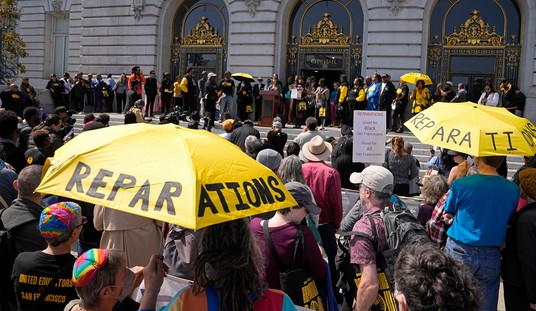The government's latest reports that the economy grew at a 3.6 percent annual rate in the third quarter and created 203,000 new jobs last month left out a lot of caveats.
Moreover, the network news media's hyperbolic reports that the economy was surging at full throttle, and the job market was strengthening, needed to be taken with a large grain of salt, too.
The truth is that the economic growth rate isn't what it's cracked up to be, and the employment figures contained a large number of "part time" holes.
The Commerce Department's surprising report that the gross domestic product, (GDP) expanded by 3.6 percent between July and September was much more the result of a backlog in unsold business inventories caused by weak consumer demand than that of a growing economy.
The Obama administration crowed that the GDP figure showed the economy was in full recovery, but economists saw many weaknesses beneath the figures.
"With third quarter GDP growth at 3.6 percent, businesses should be adding more jobs, but much of that growth was from additions to business inventories as consumers remain tightfisted and goods stay on the shelves," wrote University of Maryland business economist Peter Morici.
The bone hard, economic reality behind that percentage is that "overall consumer demand contributed about 1 percentage points to growth, whereas inventories accounted for 1.7 percent," Morici explained.
Recommended
Indeed, the Washington Post reported Friday that the third quarter pace "is unlikely to be sustained through the end of the year."
"The recovery fundamentally remains on the same slow and steady track that it has followed since the recession ended in 2009," the Post said. In fact, many economists now say they expect the economy's fourth quarter growth to decline to "less than 2 percent", the newspaper said.
The news media's exaggerated reports that Americans were pouring into the stores and buying up goods left and right doesn't hold up to closer inspection, either.
"Major apparel retailers report huge stocks of unsold goods entering the final weeks of holiday shopping. More broadly, Black Friday weekend disappointed their expectations for stronger sales than last year," says Morici.
Notably, the Reuters' news agency reported that third quarter consumer spending was the slowest since the last three months of 2009.
Consumer spending accounts for more than two-thirds of all U.S. economic activity, but it was revised downward in the government's latest figures to a barely-breathing 1.4 percent rate.
That's why many economic officials expressed caution in making any firm projections about the Obama economy in the coming year.
"I'm not prepared to interpret the revised third quarter [GDP] number as an indication that the economy is on a much stronger track," Atlanta Federal Reserve Bank President Dennis Lockhart told reporters last week.
The reason why he and other economists were voicing such caution in their forecasts is that large retail inventory in the face of weak consumer demand means a sharp fall in economic growth in the fourth quarter. And recent data seem to support that.
"Orders for manufactured goods fell 0.9 percent in October," Reuters reported.
There are also reasons to question the sustainability of last week's Labor Department survey which reported that the economy added 203,000 jobs in November. But there is less here than meets the eye.
Many reports over the course of the year have shown that employers are reducing full-time employment in favor of part-time.
Some of this is due to weaker business sales, but also to higher payroll costs under the new health care law mandates for insurance coverage.
A separate Labor Department survey "indicates 399,000 additional Americans reported working part-time since January, while 153,000 fewer say they had full-time positions," Morici said in another analysis.
"In large measure, the shift to part-timers is driven by ObamaCare mandates and a generally weak economy," he says.
The growth in low income, no-benefits, part-time work was all but missing from last week's much ballyhooed job headlines. And few if any news media reports noted that the decline in last month's jobless rate to 7.0 percent was "mostly because furloughed government workers returned to their jobs," Morici said.
While 203,000 jobs might sound like a big figure -- and it is to the White House which has become accustomed to far less muscular job numbers -- it doesn't measure up to previous recoveries.
It would take 365,000 jobs a month, and an economy growing at 4 to 5 percent a year, to reduce unemployment to 6 percent over the next two to three years.
That's not going to happened under Obama's impotent policies which call for more government spending, higher taxes and more restrictive business regulations.
Four years into President Reagan's economic recovery, after a deep recession that drove unemployment to nearly 11 percent, the economy was growing at nearly 5 percent and monthly job creation numbers were twice as high.
Few Americans fully realize that the government's job creation and unemployment numbers are from telephone surveys.
But other private sector surveys are producing data that show unemployment at higher levels than those reported by the Bureau of Labor Statistics.
For example, the respected Gallup Poll's household job survey puts the unemployment rate at 8 percent, a point higher than the government's figure.
Gallup also reports that 17.2 percent of the people they surveyed said they were working part-time or fewer hours and were "underemployed."
The bottom line is simply this. The once-mighty U.S. economy remains sluggish and undernourished because of this administration's anti-growth, anti-job policies.
This will be the No. 1 political issue for Obama and his party when the 2014 midterm election year officially begins in just 21 days.

























Join the conversation as a VIP Member